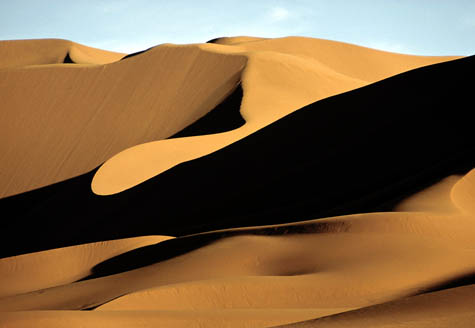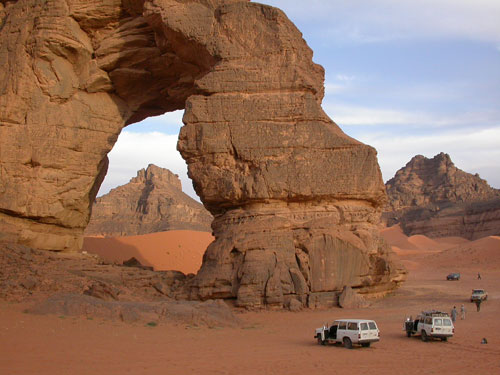It what sounds like the coolest job description going, the BBC reports that “scientists have been sailing across the Atlantic in a bid to track down sand from the Sahara Desert.” They are chasing an aerial landform while plying currents through the sea.
Terrestrial stability is nowhere in sight.
 [Image: Photo by Thomas J. Abercrombie].
[Image: Photo by Thomas J. Abercrombie].
Tracking that desert in the sky, the scientists have already “encountered two large sand storms during their cruise and recorded footage of their dust-drenched experience for the BBC News website.”
It’s airborne geology, of a different kind.
Of course, the Sahara is always popping up in unexpected places. A few quick links away from the BBC and we find that Saharan sand even peppered the ground in Wales last month; and that desert often blooms northward to cover parts of France, Italy, and Mediterranean Europe more generally, going as far north as England. It’s like some shapeless, living landmass from Greek myth – or from the tales of Scheherazade. (Leading me to wonder aloud: are the world’s religious texts an untapped resource of ideas for avant-garde landscape design?)
 [Image: The Libyan Sahara; photo ©Jacques Herman].
[Image: The Libyan Sahara; photo ©Jacques Herman].
So here’s a landscape design project for your next summer school studio: go around Europe tracking down the Sahara. Map these sites of territorial spread. Find where airborne terrains stratigraphically settle onto fields and cities elsewhere. Photograph zones of undisturbed deposition – small pockets of sand in a gully in eastern Spain – where it’s already compressing to form stone.
Then you hear rumors of a particularly violent storm that blew grains as far as Japan… and so off you go in your personal jetliner, sponsored by SCI-Arc.
In any case, the future geology of Europe will come down to it from the air, a distant lamination of the Sahara. Landscape at a distance.
If we stop sweeping the streets, what new sedimentary rocks would be forming here?
Perhaps that famous graffiti from Paris in May 1968 got it all wrong. Instead of: “Beneath the paving stones – the beach!” It should have read: “Above these roofs – the desert!”
Sailing across the Atlantic, scanning for nomadic side-storms of the Sahara, seems like a good place to start.
Just for the record, I know that the tales of Scheherazade are not a religious text; the religious text reference is actually in response to the mention of Greek myths… Just FYI.
Here’s another twist on your idea: I’ve read many references to the Sahara blowing away, mostly westward into the Atlantic. Yet here we are in western N America, Canada in my case, and the prevailing winds are blowing east. I can vouch from living in Alberta, and from watching national weather forecasts, that this holds true east of the Rockies and clear across the continent. So how fast is the Atlantic shallowing (it’s a word- I checked!) if sediments are coming at it from both sides?
While anchored at Georgetown in the Bahamas, waiting out the hurricane season one year, I noticed a fine brown dust accumulating on my boat. I learned that it was Saharan sand.
Same thing happens in Fukuoka, Japan. Some mornings you wake up to a fine layer of sand that has traveled from the other side of Beijing, across Korea and the Sea of Japan.
Wow, I never knew that the sand from the Sahara has traveled around the world. I dont know if this is cool or frighteneing, lol
part of the reason why amazon is so rich and fertile is because of the sand from sahara, bring all kinds of minerals.
The National Geographic special Strange Days on Planet Earth had a segment on Saharan dust causing Asthma in the Caribbean and killing coral. Here’s the link: http://www.pbs.org/strangedays/episodes/onedegreefactor/experts/africandust.html